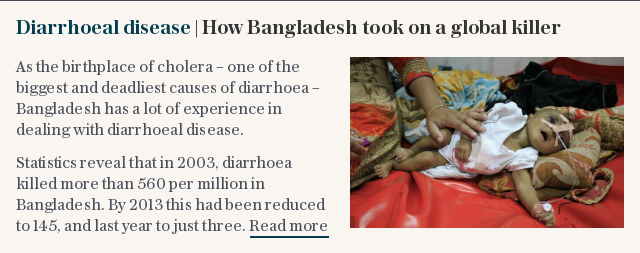New cholera tracking tool could provide more accurate picture of outbreaks

A new tool to track cholera outbreaks could give experts a more accurate geographical picture of the disease than ever before, scientists have found.
The algorithm, which analyses antibodies in blood samples to estimate cholera incidence in a region, is a major step towards a data-driven understanding of the disease.
While roughly 100,000 people die each year from cholera - an acute diarrhoeal disease transmitted through contaminated food and water - public health officials in low income countries can often make only rough estimates, based on local hospital reports of watery diarrhea.
Last December, a study warned that the number of cases of cholera reported in Yemen's recent epidemic - dubbed the world’s largest documented outbreak - was a tremendous overestimate, in part due to poor surveillance systems.
But according to the new study in the journal Science Translational Medicine, a newly developed algorithm can estimate cholera incidence with more than 90 per cent accuracy.

“We know that cholera is both under and over reported,” said Andrew Azman, assistant scientist in the department of epidemiology at the Johns Hopkins Bloomberg School of Public Health. “The outbreak in Yemen was over reported, while in other places such as in Malawi and Northern Nigeria the number of cases are likely under estimates."
“If we want to measure progress we need to be able to get a better handle on where cholera is and how much there is. The World Health Organization and global community have set up a goal to eliminate cholera by 2030, but we are a bit blind right now,” he added.
“This is one of the first steps in having a data-driven approach to tackling cholera.”
The research team analysed more than 1,500 blood samples from patients in Dhaka, Bangladesh, to develop the algorithm, confirming the model in a challenge trial with American volunteers.

As well as highlighting cholera hotpots the researchers say the tool, which can identify if and when a patient had cholera in the year before the blood sample was collected, could be used to monitor progress in the fight against the disease.
“The ability to see a cross sectional snapshot of cholera, which enables us to estimate incidence, is a major advance for the field,” said Dr Daniel Leung, assistant professor in the department of infectious diseases at the University of Utah Health.
“This will help us prioritise regions and track the progress of interventions, such as vaccines and improved sanitation,” he said.
Though laboratory testing of blood samples is expensive, the team said that the process was cheaper and more realistic than the alternative - improving healthcare infrastructure to allow more accurate diagnosis.
“Cholera is a disease of poverty, and so it occurs in places that have the poorest health systems in the world,” said Prof Azman. “Expecting them to have perfect surveillance systems is a pipe dream.”
Protect yourself and your family by learning more about Global Health Security

 Yahoo News
Yahoo News 
